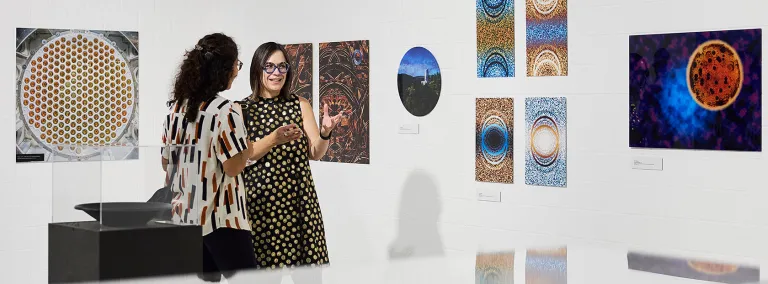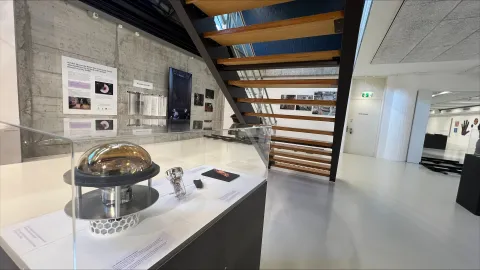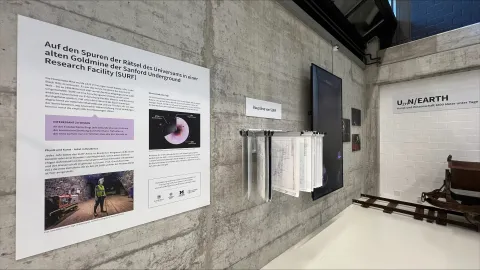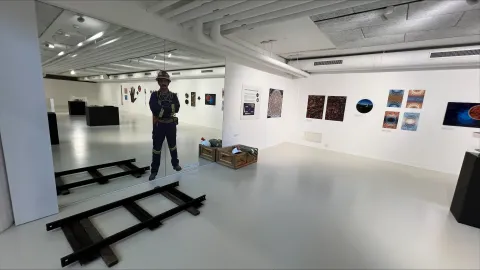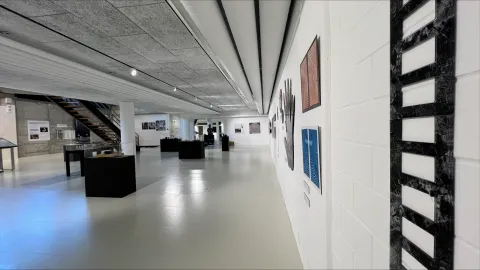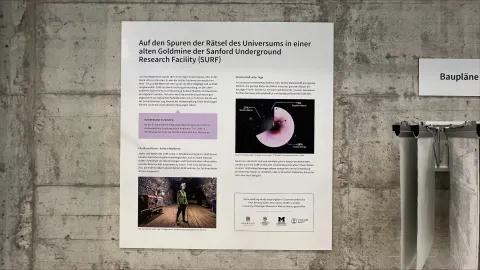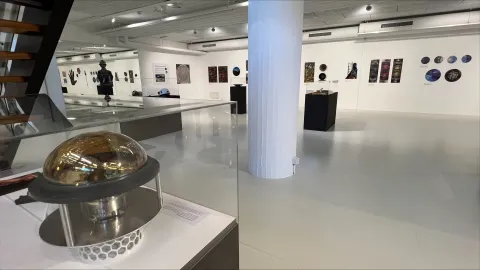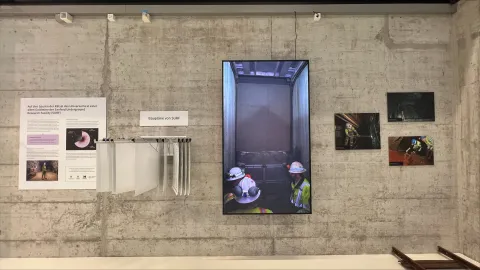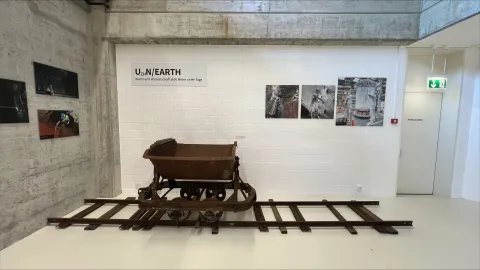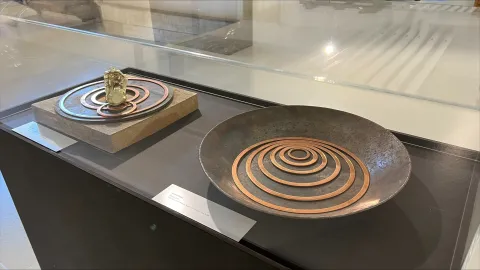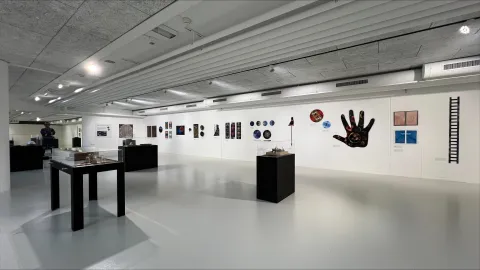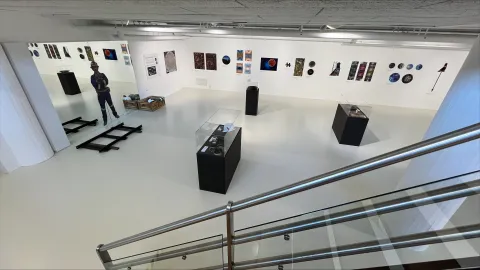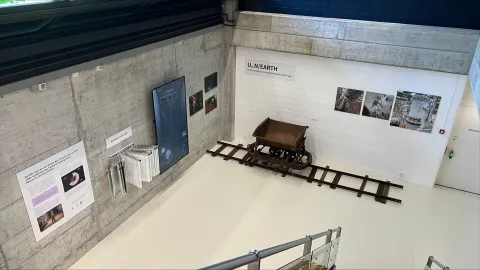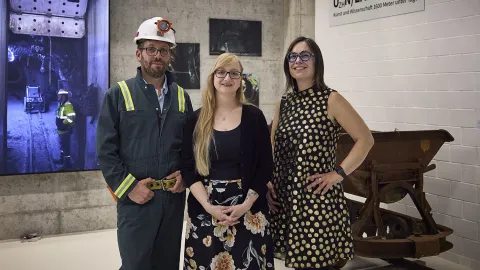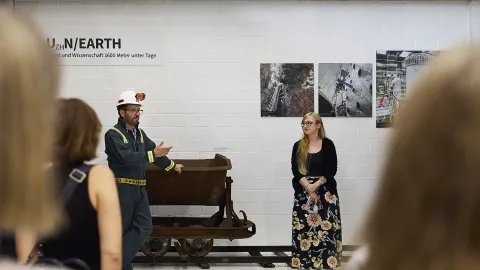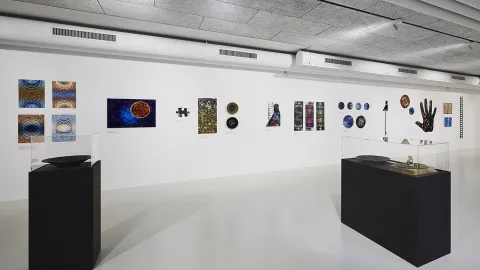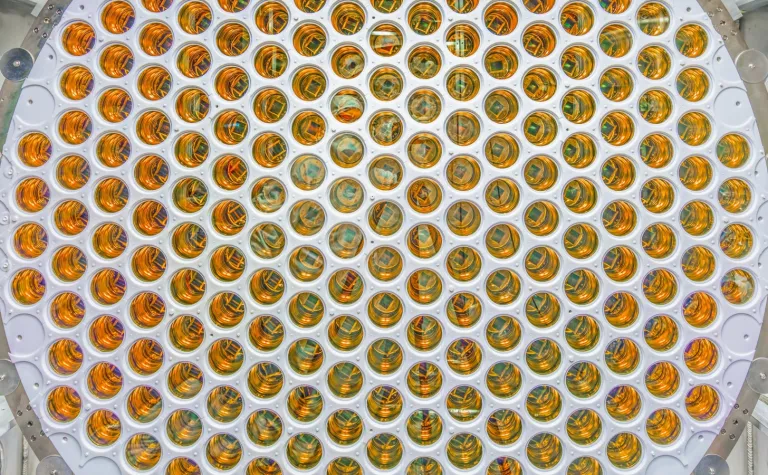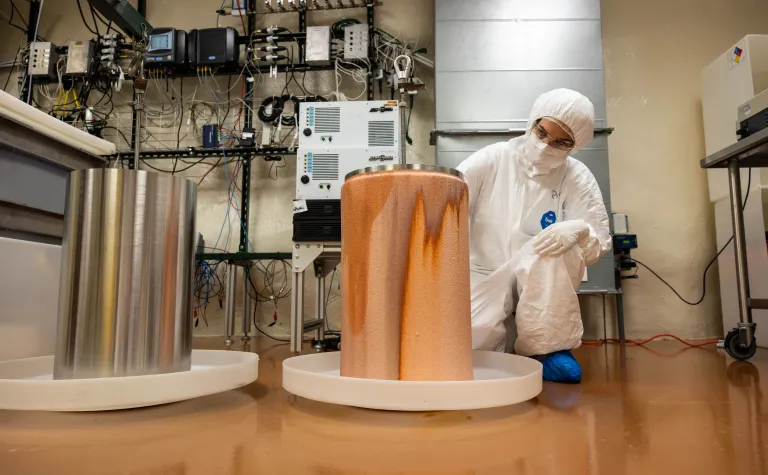Making the invisible visible
Gina Gibson, SURF’s AiR coordinator, presents artwork in Switzerland alongside dark matter physicist Björn Penning.
In a new exhibition "UZHN/EARTH - Art and Science 1600 Meters Underground," at the University of Zurich’s (UZH) Science Pavilion on the Irchel Campus, visitors can embark on a journey into the hidden depths of the Sanford Underground Research Facility (SURF). The exhibition includes photos from SURF that are complemented with artwork made by artist Gina Gibson, a professor at Black Hills State University, and the coordinator for the Artist in Residence (AiR) program at SURF.
In the 1930s, the Swiss astronomer Fritz Zwicky discovered a large amount of invisible matter in the universe. He called it "dark matter.” Today, scientists know that dark matter influences the universe in many ways, including the development of galaxies. Researchers are trying to detect and measure dark matter. But they are still faced with the mystery of what exactly dark matter consists of.
Physics experiments in a former gold mine
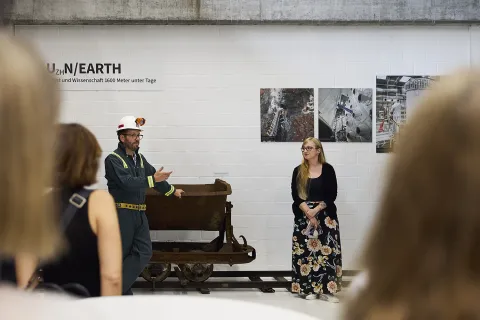
UZH physics professor Björn Penning (left) speaks during an opening program for the exhibit. He is joined by exhibit curator Melanie Widmer, at the UZH Science Pavilion.
Photo thanks to the University of Zurich
UZH physics professor Björn Penning is part of a research collaboration that is taking what might seem like an unusual approach to tackling the problem. Scientists, like Penning, are working at great depths to try and uncover the secrets of dark matter and neutrinos—elementary particles with very low mass. Before his appointment at UZH, Penning joined a collaboration doing physics research in a former gold mine in the United States on particle physics experiments. The Homestake Mine, in South Dakota, was once considered the deepest gold mine in North America; its tunnels reach a depth of about 8000 feet or 2400 meters. Gold was mined there until 2001. Today the former mine has been converted into a dedicated laboratory space. SURF is the deepest underground laboratory in the United States. The facility houses several experiments across many fields from dark matter and neutrino physics, to biology, geology and engineering.
A universe full of WIMPs
But why are Penning and his team conducting particle physics experiments in such a remote and difficult-to-access location? The new exhibition, in the UZH Science Pavilion in Zurich Switzerland, explains this question in a clear way: the many tons of rock above and around the deep laboratory space shield the constant rain of cosmic particles that can otherwise interfere with measurements of rare physical events. "The experiments are taking place in one of the least radioactive places in the world," said Penning. The physicist works with the world's most sensitive detector, the LUX ZEPLIN (LZ), to search for theoretical dark matter particles called "WIMPs” or Weakly Interacting Massive Particles. Researchers suspect that the universe could be full of WIMPs. But because they interact so little, they cannot be seen or examined using conventional methods. This is why Penning and other scientists are experimenting in the shielded world of the underground lab. The detection of WIMPs would be groundbreaking because Penning, and others in the research collaboration, would thereby prove the existence of dark matter.
Combination of art and physics
At the vernissage, Gina Gibson explains her artwork. Gibson is a professor of graphic design at Black Hills State University in Spearfish, South Dakota. She was SURF’s first artist-in-residence in 2019. Today she leads the Artist-in-Residence Program at the underground laboratory. Gibson joined researchers, including Penning, at SURF during the research. Her fascination with particle physics is evident in her art, which is an important part of the new exhibition at the Irchel Campus.
Art and physics are two subjects that may not seem to have much in common for many people. "But it's precisely this combination that is particularly appealing," said Morana Mihaljevic, head of the Science Lab & Science Pavilion UZH. "Gibson shows a different side of research. For example, she selects everyday objects such as power cables and presents them artistically."
“It is an honor to work beside world class researchers. I have found we share curiosity and creativity. Artist-in-residence programs intentionally foster interdisciplinary exchanges and gives the public new ways to understand the research being done at places like SURF,” Gibson said.
UZH at the cutting edge of dark matter research
The exhibit includes more than particle physics research at SURF. The research of UZH physicist Laura Baudis is also featured at the UZH Science Pavilion. The experiments at CERN, in which UZH is also involved, are discussed in a separate section of the exhibition.
The exhibition is suitable for all ages and backgrounds and an excellent choice for families and school children. The first floor of the exhibit, in the lower half of the building, recreates the feeling and the darkness of being inside an underground science laboratory or a mine. Tracks from former mine tunnels and mining carts provide an authentic underground experience. "The Swiss Association of Field and Industrial Railway Friends made them available to us," says curator Melanie Widmer. "The exhibition gives a good overview of the research at SURF in the field of dark matter," says Widmer. "And who knows, maybe we will soon know more about what holds the world together."
Information about the exhibition in Switzerland
Exhibition:UzhN/EARTH
Duration: Until the end of May 2025
Where:Science Pavilion UZH
Opening hours: daily 12:00-3:00 p.m.
This article was originally posted by the University of Zurich translated from German and added to SURF’s website with permission.
